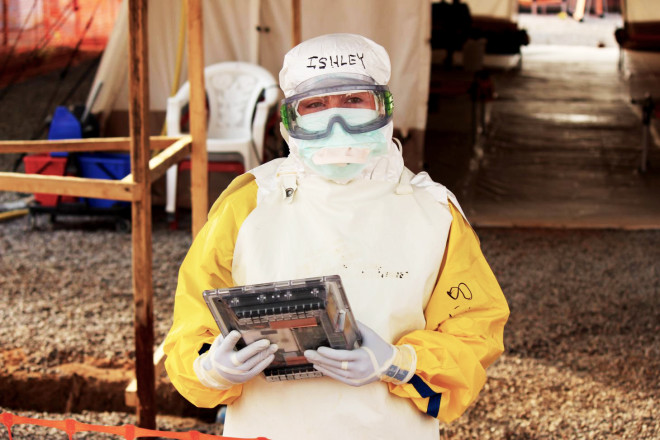
Jay Achar was treating Ebola patients at a makeshift hospital in Sierra Leone, and he needed more time.
This was in September, near the height of the West African Ebola epidemic. Achar was part of a team that traveled to Sierra Leone under the aegis of a European organization called Médecins Sans Frontières, or Doctors Without Borders. In a city called Magburaka, MSF had erected a treatment center that kept patients carefully quarantined, and inside the facility’s high-risk zone, doctors like Archar wore the usual polythene “moon suits,” gloves, face masks, and goggles to protect themselves from infection.
With temperatures rising to about 90 degrees Fahrenheit, Achar could stay inside for only about an hour at a time. “The suit doesn’t let your skin breathe. It can’t,” he says. “You get very, very hot.” And even while inside, so much of his time was spent not treating the patients, but merely recording their medical information—a tedious but necessary part of containing an epidemic that has now claimed an estimated 10,000 lives. Due to the risk of contamination, he would take notes on paper, walk the paper to the edge of the enclosure, shout the information to someone on the other side of a fence, and later destroy the paper. “The paper can’t come out of the high-risk zone,” he says.
Looking for a better way, he phoned Ivan Gayton, a colleague at the MSF home office in London. Gayton calls himself a logistician. He helps the organization get stuff done. In 2010, he tracked down someone at Google who could help him use its Google Earth service to map the locations of patients during a cholera epidemic in Haiti. As part of its charitable arm, Google.org, the tech giant runs a “crisis response team” that does stuff like this. So, after talking to Achar, Gayton phoned Google again, and the company responded with a new piece of tech: a computer tablet that could replace those paper notes and all that shouting over the fence.
The Tablet You Dunk in Chlorine
Over the next few months, drawing on employees from across the company, Google helped build a specialized Android tablet where Achar and other doctors could record medical info from inside the high-risk zone and then send it wirelessly to servers on the outside. Here in everyday America, a wireless tablet may seem like basic technology. But in the middle of an Ebola epidemic in West Africa, which offers limited internet and other tech infrastructure, it’s not.

The tablet is encased in polycarbonate, so that it can be dipped in chlorine and removed from the facility, and the server runs on battery power. “There was a real need for this,” says Dr. Eric D. Perakslis, part of the department of biomedical informatics at the Harvard Medical School, who has closely followed the project. “It’s very impressive, and it’s unique.”
The system is now used by Achar and other doctors in West Africa, where patients are still being treated. During the testing phase, the server ran off a motorcycle battery, but now it includes its own lithium ion batteries, much like those in your cell phone, which can charge via a portable generator. Then, inside the high-risk zone, Archar can not only wirelessly send data over the fence, but also readily access information he didn’t have before, including a patient’s latest blood test results. Plus, after dipping the thing in chlorine for ten minutes, he can take it outside the zone and continue working with it after removing his moon suit.
Yes, the Ebola epidemic appears to be wane. But the system provides a blueprint for future. After catching wind of the project, Perakslis says, he’s working to help MSF “open source” the technology, freely sharing the software code and hardware designs with the world at large. The hope is that system could also be used to battle others epidemics, including cholera outbreaks, and perhaps help with medical research, including clinical trials for drug-resistant tuberculosis. “You can think of other highly toxic environments, even laboratory environments, where this could really be helpful,” Perakslis says.
Fighting Disease Like a Tech Company
But it could also provide a path to all sorts of other new technologies for fighting disease and illness in developing countries. If tech is open source, you see, you can not only use it for free, but modify it. This is actually what MSF and Google themselves did in creating their system for the Ebola wards. In fashioning the software that runs on the tablet and server, they built atop an existing open source medical records tool called OpenMRS. One technology is just a starting point for another.
What’s more, says Ivan Gayton, the project offers a lesson in how organizations like MSF should operate. In the past, they operated according to carefully organized hierarchies of employees. And they were forced to use what came down from the big software and hardware sellers. But the tablet project was an almost ad-hoc collaboration. Achar phoned Gayton. Gayton phoned Google. Soon, Google sent about a dozen employees to London, including Google Drive project manager Ganesh Shakar, who was living in Australia. Later, Gayton says, MSF roped in several other volunteer techies from outside the organization, including a 19-year-old gaming entrepreneur.
Finally, various parts of the team, spanning multiple organizations, flew down to Sierra Leone to test and deploy the system in the real world. Organizations like MSF don’t typically work in this way, Gayton explains. And they should.
“We’ve learned new ways of doing things,” he says. “In the past, we used the Roman-legion, hierarchical, triangle structure. But Google and the tech volunteers we work with organize in different ways—ways more like what you see with open source projects like Linux, with more or less one manager and then a bunch of equal peers. That can have profound implications for the humanitarian field.”
